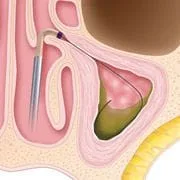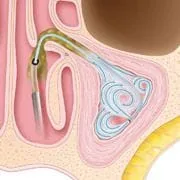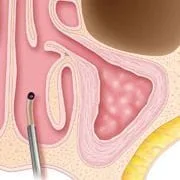Balloon Sinuplasty (BSP) uses a small, flexible, balloon catheter to open up blocked sinus passageways and facilitate drainage of the mucus that builds up in patients suffering from chronic sinusitis. When the sinus balloon is inflated, it restructures and widens the walls of the sinus passageway while maintaining the integrity of the sinus lining.
Unlike traditional sinus surgery, Balloon Sinuplasty requires no cutting and no removal of bone and tissue. Published clinical data in the leading ENT journal shows that it is safe and effective: patients experienced no adverse events and received statistically and clinically significant improvement in their sinusitis symptoms. ( 1 )
The following illustrations show how Balloon Sinuplasty opens a blocked left maxillary sinus:

|
Step 1. A balloon catheter is inserted into the inflamed sinus.

|
Step 2. The balloon is inflated to expand the sinus opening.

|
Step 3. Saline is sprayed into the inflamed sinus to flush out the pus and mucus.

|
Step 4. The system is removed, leaving the sinuses open.

|
Balloon Sinuplasty
is typically performed under general anesthesia in an outpatient setting. It is now also available to some patients as a procedure conducted in a doctor’s office under local anesthesia.
Clinical data shows that Balloon Sinuplasty provides symptom relief:
- 95% of patients demonstrated that sinus symptoms improved in an average follow-up period of 9 months in a multi-center study of 1,036 patients who had Balloon Sinuplasty ( 2 )
- Another multi-center study followed 65 patients who had Balloon Sinuplasty and reported clinically and statistically significant improvement in patient symptoms out to two years . ( 1 )
- 95% percent of patients who had Balloon Sinuplasty would recommend the procedure to their family and friends. ( 3 )
Watch the Balloon Sinuplasty video.
Take the Balloon Sinuplasty Quiz .
Sources
- Weiss, et al. “Long-term outcome analysis of balloon catheter sinusotomy: Two-year follow-up.” Otolaryngology-Head and Neck Surgery, 2008, Vol. 139, pp. S38-S46.
- Levine, et al. Multicenter Registry of Balloon Catheter Sinusotomy Outcomes for 1,036 Patients, Annals of Otology, Rhinology, and Laryngology, 2008, Vol. 117, pp. 263-270.
-
ORIOS I, office-based dilation, Data on file at Acclarent.
Animation Transcript
The sinuses are a series of inter-connected, hollowed spaces in the skull. Their walls are lined with mucus-secreting membranes. Small hairs sweep the mucus out of the sinuses so it can drain out through your nose. These mucus membranes may become infected or inflamed because of a cold or allergies, and can swell up and block the nasal passages so that fluid from the sinuses can't drain. Buildup of fluid in the sinuses causes pressure and pain. Doctors call this sinusitis.
Acute sinusitis comes on quickly and then leaves. With chronic sinusitis, people have symptoms virtually all the time, and take many courses of medications such as antibiotics to treat the inflammation. Severe sinusitis may require surgical opening of the passageways with rigid steel instruments placed up through the nostril to remove bone and tissue blocking the drainage.
Recently, a new, less invasive technology called Balloon Sinuplasty has been introduced. Using this technology a balloon catheter is delivered to the blocked passageway, and is gently inflated, widening the opening of the passageway and thus allowing drainage and relief from the pain and pressure.
